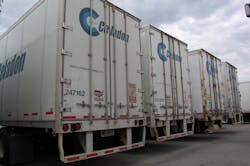There’s a mix of good and not-so-good news in the most recent freight outlook compiled by research firm FTR Associates, with a significant “downside” risk to the industry posed by the ongoing sovereign debt troubles in Europe as well as the growing potential for an economic slowdown in China.
During the company’s quarterly State of Freight webinar yesterday, FTR Senior Consultant Noel Perry pointed out that there’s “much more uncertainty” in the current pile of freight data for the trucking industry, yet also stressed a lot of positive things are occurring as well.
On the negative side, there’s a downward trend in orders for durable goods, which Perry said indicates a growing “wariness” by businesses and consumers alike. “We’ll need to watch this closely,” he pointed out. “The question is whether this is the beginning of a general downward trend?”
While tonnage inched up in recent months – with the American Trucking Assns. (ATA) for-hire truck tonnage index increasing 0.4% in September after recording a 0.9% decline in August – Perry noted that just 11 out of 200 commodities are responsible for the bulk of that freight; some 67% of the tonnage now rolling trucking’s trailers.
On the plus side, though, Perry said sales of existing housing homes are approaching “normal” territory, while automotive sales are almost back to normal – though he cautioned auto sales won’t return to the 16 million to 17 million production volume levels experienced in North American prior to the “Great Recession.”
Diesel prices, while much higher than in the past, are now stabilizing and Perry expects this high but “flat” price level to extend out until 2015 barring a major crisis, such as a “hot” war in the Middle East.
The devastation wreaked by Hurricane Sandy is also expected to pump up freight levels in the short term for trucking, Perry noted, as he estimates trucking should garner a big share of the roughly $10 billion to $15 billion worth of transportation business as the Northeast begins to rebuild from the “super storm” – and he expects storm-related transportation demand to peak in April next year.
Yet global economic trends continue to cast a shadow on trucking’s prospects, Perry stressed. Europe’s sovereign debt crisis for starters is already affecting the U.S. economy, reducing the nation’s gross domestic product (GDP) by 0.5%. He said that’s significant because the 2% GDP growth is the “magic number” for trucking – above that level, freight grows rapidly, but when GDP drops below it, tonnage falls just as rapidly.
Perry pointed out that with the U.S. GDP only expected to grow by 2% to 2.5% next year, the impact of a European economic collapse would be severe – shaving 1% to 1.5% off U.S. GDP, substantially reducing economic growth or even pushing the county back into a recession.
The U.S. sovereign debt – now hovering around $16 trillion – also poses significant risk economic risk should the holders of that debt push for higher interest rates. “At some point we will get caught like Europe,” Perry said. “The economies of Spain and Italy are reeling from 5% to 6% interest on their debt. But if we [the U.S.] just get interest rates of 2% to 3%, we’ll go back into recession.”
The historical trend lines for economic recessions and recoveries also pose a worry as well, according to Perry. “It’s worth noting that the average length of a U.S. economic recovery since the 1970s is about 17 quarters or 4.5 years,” he explained. “By that reckoning, the start of the next recession should be the fourth quarter of 2013.”
Perry added that economic slowdowns tend to materialize every five years or so on average according to historical economic data, so even if a recession does not occur late next year, there’s still a 70% to 80% chance of some sort of economic slowdown occurring by mid-decade.
From a trucking operations standpoint, Perry noted that the industry overall is only buying about half of the “discretionary” trucks that it did during the 2003-2005 U.S. economic recovery period due to the higher sticker price of new trucks themselves, higher fuel prices, and a growing lack of drivers.
As a result, trucking capacity is expected to go from “moderately” tight to “severely” tight by mid-2013, mainly due to a shortage of drivers estimated to range between 100,000 and 300,000.
“Things are going to get tighter for trucking, even if the economic recovery keeps going,” Perry said.
About the Author
Sean Kilcarr
Editor in Chief
Sean Kilcarr is a former longtime FleetOwner senior editor who wrote for the publication from 2000 to 2018. He served as editor-in-chief from 2017 to 2018.
